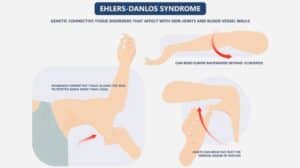By Andrew Siyabalawatte, Oct 2022
Normal vs Joint Hypermobility

Normal joints allow the body to move within a specific range of motion (ROM) without compromising joint integrity. Conditions such as Nonsyndromic and Ehlers-Danlos syndrome (EDS) commonly associate with them.
Nonsyndromic and Ehlers-Danlos syndrome (EDS) are the commonest conditions associated with them.
Joint Hypermobility and Pain

Joint Hypermobility is a frequent cause of chronic pain and fatigue, affecting at least 3% of the general population. Its tissues are characterized by being highly stretchy and soft to the touch, often described as “dough-like skin.”
Other commonly associated conditions include scoliosis, fibromyalgia, gout, rheumatoid arthritis, and digestive issues.
How Do You Know If You Are Joint Hypermobile?

The Beighton Scoring System measures on a 9-point scale. The joints are:
- Knuckle of both little/fifth/pinky fingers
- Base of both thumbs
- Elbows
- Knees
- Spine
How To Treat Joint Hypermobility
Massage therapy, osteopathy, and chiropractic treatment can help relieve associated pain, allowing you to focus on connective tissues for long-term joint stability.
At Back To Health Wellness, we assist many clients in achieving this goal. Book a session with us and let us help you on your path to optimum health!

